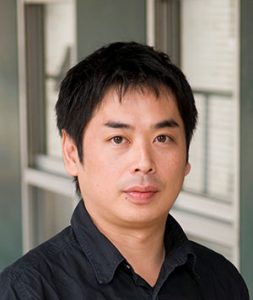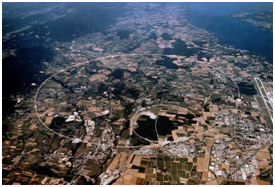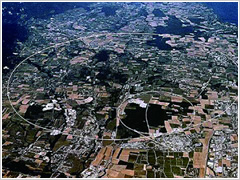
ページ読込中...

ページ読込中...

[English]
| 寄田 浩平 [教授] |  |
|
| homepage | https://www2.kylab.sci.waseda.ac.jp/ | |
| 専門分野 | 素粒子実験物理学 | |
| 研究テーマ・研究活動 | ||
| ○LHC/ATLAS実験におけるヒッグス粒子解析、新粒子・新 ○宇宙暗黒物質探索 ○次世代実験へ向けての検出器開発 |
||
| ●日本物理学会 ●アメリカ物理学会 |
||
我々のグループの究極目標は『物質の根源、究極粒子とは何か?』と『そこに働く物理法則は?』という極めて素朴で本質的な疑問を実験的に解明し、科学の言葉で理解することです。クォーク、レプトンとゲージ粒子で素粒子の世界を記述するモデルを一般に素粒子の「標準理論」と呼びます。この標準理論は非常に整合性のある有効な理論体系であり、実際これまでの様々な実験データを見事に説明してきました。しかし一方で、まだまだわからないことだらけの分野、不完全な有効理論であるということも事実です。たとえば、暗黒物質、階層性の問題や力の統一などの究極的な疑問に、まだ完全に答えることができていません。こういった究極の問題を解くために世界中の実験物理学者は長きにわたり、より高エネルギー状態を生成しうる加速器の建設に挑戦してきました。なぜなら、素粒子の現象はこういった高エネルギーで現れるからです。E=Mc2 からもわかるとおり、「より高いエネルギー」は「より重い粒子を生成」することができます。また一方、「より高いエネルギー」は「より初期の宇宙の状態を人工的につくっている」ともいえるのです。
 具体的には、現代のエネルギーフロンティア実験であるLHC実験(スイス:円周27km、13~14TeVの加速器、図参照)に参加し、素粒子の生成や質量などの精密測定による理論の検証や全く新しい粒子、新しい現象の発見に力を注いでいます。特に、2012年にLHC実験で発見した「ヒッグス粒子」の詳細研究が重要な課題の一つです。ヒッグス粒子の研究は、素粒子の質量起源、電弱対称性の破れ、真空の構造の解明につながるだけでなく、全く新しい現象のプローブとなる可能性が高いからです。また、標準理論を超えた新現象、「超対称性粒子の発見」や「余剰次元現象」、「暗黒物質生成過程」等のの新現象直接探索も行っています。このような最前線の研究において、我々のグループも世界中の研究者と協力、時には競い合いながら、その役割を責任をもって推進しています。一方、大規模実験ではなく、自分たちで高感度検出器を開発・構築し、地下施設に持ち込み、地球を通過する暗黒物質を捉える実験も並行して進めています。これらは二つは、大小様々、異なるアプローチですが、目的は共通です。さらに先へ、次世代の新しい実験構想や検出器の開発にも積極的に携わり、素粒子物理学と宇宙物理学における新しい扉を実験に開くことを目標におき日々研究に励んでいます。
具体的には、現代のエネルギーフロンティア実験であるLHC実験(スイス:円周27km、13~14TeVの加速器、図参照)に参加し、素粒子の生成や質量などの精密測定による理論の検証や全く新しい粒子、新しい現象の発見に力を注いでいます。特に、2012年にLHC実験で発見した「ヒッグス粒子」の詳細研究が重要な課題の一つです。ヒッグス粒子の研究は、素粒子の質量起源、電弱対称性の破れ、真空の構造の解明につながるだけでなく、全く新しい現象のプローブとなる可能性が高いからです。また、標準理論を超えた新現象、「超対称性粒子の発見」や「余剰次元現象」、「暗黒物質生成過程」等のの新現象直接探索も行っています。このような最前線の研究において、我々のグループも世界中の研究者と協力、時には競い合いながら、その役割を責任をもって推進しています。一方、大規模実験ではなく、自分たちで高感度検出器を開発・構築し、地下施設に持ち込み、地球を通過する暗黒物質を捉える実験も並行して進めています。これらは二つは、大小様々、異なるアプローチですが、目的は共通です。さらに先へ、次世代の新しい実験構想や検出器の開発にも積極的に携わり、素粒子物理学と宇宙物理学における新しい扉を実験に開くことを目標におき日々研究に励んでいます。
| Kohei Yorita [Professor] |  |
|
| homepage | https://www2.kylab.sci.waseda.ac.jp/ | |
| research field | Experimental Particle Physics | |
| research keywords | ||
| LHC/ATLAS/CERN, Higgs Boson, Supersymmetry, Dark Matter Search, Detector R&D |
||
| link | ||
| Research Profiles (at Faculty of Science and Engineering) | ||
What is the Universe made of And by what laws?
– Joining the world’s highest energy accelerator-based experiments, LHC, gives Waseda University a core role in the new revolution in particle physics to emerge in the near future.
The Standard Model (SM) of elementary particle physics (a gauge theory of electroweak and strong interactions) has so far fared well against experimental data, possibly creating the impression that it can resolve all problems. In fact, it is merely an effective theory at certain energy scales. We are still unable to clearly answer the simple questions: What is the Universe made of ?, What is ultimate unification of the forces ?, What is the Dark Matter, said to account for 25% of the universe’s mass ? e.t.c.
 To answer these questions, we first need to investigate newly discovered particle, called the Higgs boson in more details and of course look for physics beyond the SM. As an experimental approach, the world’s highest energy accelerator experiment is carried out at CERN’s LHC (proton-proton collider operating at center-of-mass energies of 13-14TeV) in Europe. The detailed studies for the Higgs boson is possible only there. Waseda University has joined the ATLAS/LHC experiment, in which the Higgs boson was discovered in 2012, and has continuously provided high-level results in a variety of physics. The LHC is the focus of larger expectations. Namely finding the new phenomena beyond the SM is the primary goal of the LHC. For example, the supersymmetry particle (SUSY) may be found and/or new phenomena related to extra dimensions may emerge. Also one of SUSY particles could be a candidate for dark matter. The Japanese group has made significant contributions to the LHC/ATLAS project. And my laboratory, currently only the experimental high energy group from Waseda University has also been heavily involved in and working on the ATLAS as a member of this large-scale international experimental project to look for new physics beyond the SM.
To answer these questions, we first need to investigate newly discovered particle, called the Higgs boson in more details and of course look for physics beyond the SM. As an experimental approach, the world’s highest energy accelerator experiment is carried out at CERN’s LHC (proton-proton collider operating at center-of-mass energies of 13-14TeV) in Europe. The detailed studies for the Higgs boson is possible only there. Waseda University has joined the ATLAS/LHC experiment, in which the Higgs boson was discovered in 2012, and has continuously provided high-level results in a variety of physics. The LHC is the focus of larger expectations. Namely finding the new phenomena beyond the SM is the primary goal of the LHC. For example, the supersymmetry particle (SUSY) may be found and/or new phenomena related to extra dimensions may emerge. Also one of SUSY particles could be a candidate for dark matter. The Japanese group has made significant contributions to the LHC/ATLAS project. And my laboratory, currently only the experimental high energy group from Waseda University has also been heavily involved in and working on the ATLAS as a member of this large-scale international experimental project to look for new physics beyond the SM.
On the other hand, we have developed new high-sensitive detector to search for the dark matter in the Universe, passing through the earth. This is so called “underground-experiment”, not the accelerator based experiment like LHC. The approaches/technologies are completely different, but goal is the same, hunting for the Dark Matter, searching for any physics beyond the SM and even unexpected physical laws that govern the universe.
Furthermore we continue to move ahead, marshalling a critical intellectual curiosity, to search for the truth. New discoveries create new mysteries. This profound world is as limitless as the curiosity and ceaseless efforts of we human beings.